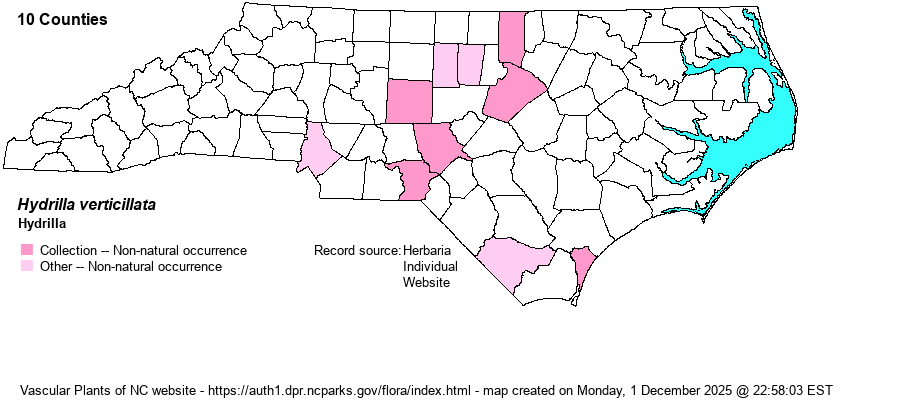| Author | (L. fils) Royle | |
| Distribution | So far, mostly lower Piedmont and Sandhills; disjunct to Columbus and New Hanover counties. First collected in NC in 1980. Specimens from Nash County (at NCU) are Egeria densa. This species is spread from bodies of water on boat propellers, and probably on the legs of waterfowl, and thus certainly occurs in other counties now.
Native of Old World; in N.A. from CT to FL and TX; also CA. | |
| Abundance | Frequent to locally abundant in Wake County (8+ locations known), apparently rare to uncommon elsewhere, but likely overlooked. This Federal noxious weed will certainly turn up elsewhere. | |
| Habitat | Nutrient-rich or disturbed impoundments and ponds. Unfortunately, it has turned up in natural settings -- the Eno River in Orange County and Lake Waccamaw in Columbus County. | |
| Phenology | | |
| Identification | It is most similar to Egeria, but it possesses prickles along the leaf margins and also on the central leaf vein beneath. The flower is also on a long stalk, but small and inconspicuous (vs. 3 showy white petals). Most NC specimens have slender leaves, but a few have broad ones. It should remind the layperson of aquatic "green tinsel", floating in the water, or submerged under the water surface. | |
| Taxonomic Comments | Weakley (2024) lists two subspecies for it in NC -- peregrina and verticillata. The first occurs in the mountains and Piedmont, and the latter in the Coastal Plain. However, as this is a non-native species, the authors are not now writing individual accounts for these subspecies.
| |
| Other Common Name(s) | | |
| State Rank | SE | |
| Global Rank | GNR | |
| State Status | | |
| US Status | | |
| USACE-agcp | OBL link |
| USACE-emp | OBL link |

